Yamaha PSR-E323, YPT-320 User Manual
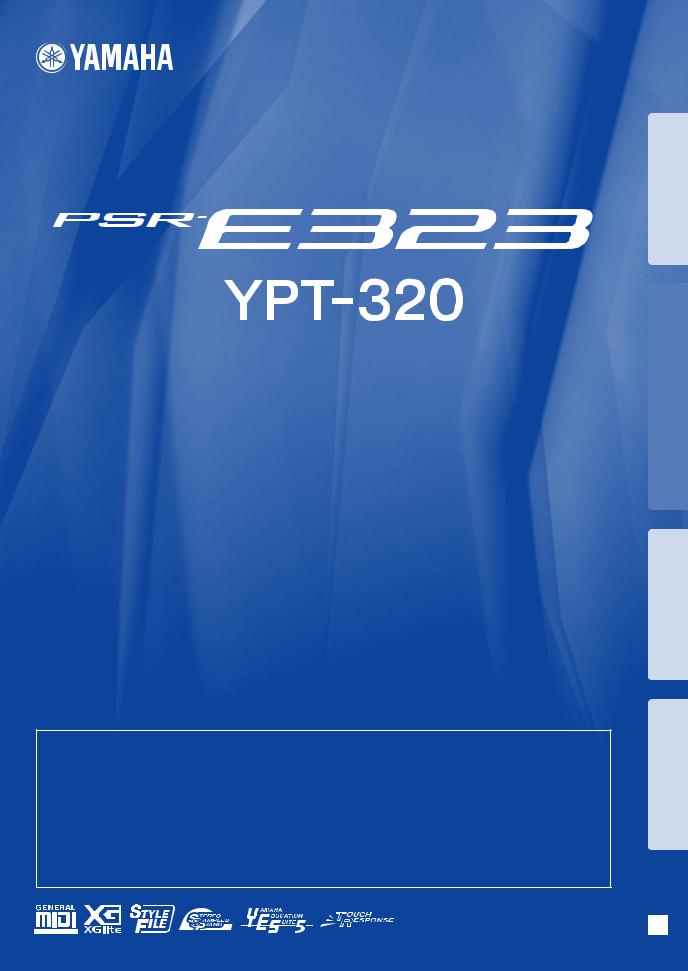
DIGITAL KEYBOARD
Owner’s Manual
How to use this manual
Before using the PSR-E323/YPT-320, be sure to read the “PRECAUTIONS” section on pages 4–5. Follow the instructions described in “Setting Up,” then try out the simple operations in “Quick Guide.” “Reference” provides detailed descriptions and procedures for getting the most out of the instrument. After you’ve read the manual, keep it safe and handy for future reference.
Data List
The Data List contains MIDI related information. The Data List is available for downloading from the Yamaha Manual Library at: http://www.yamaha.co.jp/manual/
Setting Up
Quick Guide
Reference
Appendix
EN

SPECIAL MESSAGE SECTION
This product utilizes batteries or an external power supply (adapter). DO NOT connect this product to any power supply or adapter other than one described in the manual, on the name plate, or specifically recommended by Yamaha.
This product should be used only with the components supplied or; a cart, rack, or stand that is recommended by Yamaha. If a cart, etc., is used, please observe all safety markings and instructions that accompany the accessory product.
This product may also use “household” type batteries. Some of these may be rechargeable. Make sure that the battery being charged is a rechargeable type and that the charger is intended for the battery being charged.
When installing batteries, do not mix batteries with new, or with batteries of a different type. Batteries MUST be installed correctly. Mismatches or incorrect installation may result in overheating and battery case rupture.
Warning:
SPECIFICATIONS SUBJECT TO CHANGE:
The information contained in this manual is believed to be correct at the time of printing. However, Yamaha reserves the right to change or modify any of the specifications without notice or obligation to update existing units.
Do not attempt to disassemble, or incinerate any battery. Keep all batteries away from children. Dispose of used batteries promptly and as regulated by the laws in your area. Note: Check with any retailer of household type batteries in your area for battery disposal information.
Disposal Notice:
This product, either alone or in combination with an amplifier and headphones or speaker/s, may be capable of producing sound levels that could cause permanent hearing loss. DO NOT operate for long periods of time at a high volume level or at a level that is uncomfortable. If you experience any hearing loss or ringing in the ears, you should consult an audiologist.
IMPORTANT: The louder the sound, the shorter the time period before damage occurs.
NOTICE:
Service charges incurred due to a lack of knowledge relating to how a function or effect works (when the unit is operating as designed) are not covered by the manufacturer’s warranty, and are therefore the owners responsibility. Please study this manual carefully and consult your dealer before requesting service.
ENVIRONMENTAL ISSUES:
Yamaha strives to produce products that are both user safe and environmentally friendly. We sincerely believe that our products and the production methods used to produce them, meet these goals. In keeping with both the letter and the spirit of the law, we want you to be aware of the following:
Battery Notice:
This product MAY contain a small non-rechargeable battery which (if applicable) is soldered in place. The average life span of this type of battery is approximately five years. When replacement becomes necessary, contact a qualified service representative to perform the replacement.
Should this product become damaged beyond repair, or for some reason its useful life is considered to be at an end, please observe all local, state, and federal regulations that relate to the disposal of products that contain lead, batteries, plastics, etc. If your dealer is unable to assist you, please contact Yamaha directly.
NAME PLATE LOCATION:
The name plate is located on the bottom of the product. The model number, serial number, power requirements, etc., are located on this plate.You should record the model number, serial number, and the date of purchase in the spaces provided below and retain this manual as a permanent record of your purchase.
Model
Serial No.
Purchase Date
PLEASE KEEP THIS MANUAL
92-BP (bottom)
2 PSR-E323/YPT-320 Owner’s Manual

FCC INFORMATION (U.S.A.)
1. IMPORTANT NOTICE: DO NOT MODIFY THIS UNIT!
This product, when installed as indicated in the instructions contained in this manual, meets FCC requirements. Modifications not expressly approved by Yamaha may void your authority, granted by the FCC, to use the product.
2. IMPORTANT: When connecting this product to accessories and/or another product use only high quality shielded cables. Cable/s supplied with this product MUST be used. Follow all installation instructions. Failure to follow instructions could void your FCC authorization to use this product in the USA.
3. NOTE: This product has been tested and found to comply with the requirements listed in FCC Regulations, Part 15 for Class “B” digital devices. Compliance with these requirements provides a reasonable level of assurance that your use of this product in a residential environment will not result in harmful interference with other electronic devices. This equipment generates/ uses radio frequencies and, if not installed and used according to the instructions found in the users manual, may cause interference harmful to the operation of
other electronic devices. Compliance with FCC regulations does not guarantee that interference will not occur in all installations. If this product is found to be the source of interference, which can be determined by turning the unit “OFF” and “ON”, please try to eliminate the problem by using one of the following measures:
Relocate either this product or the device that is being affected by the interference.
Utilize power outlets that are on different branch (circuit breaker or fuse) circuits or install AC line filter/s.
In the case of radio or TV interference, relocate/reorient the antenna. If the antenna lead-in is 300 ohm ribbon lead, change the lead-in to co-axial type cable.
If these corrective measures do not produce satisfactory results, please contact the local retailer authorized to distribute this type of product. If you can not locate the appropriate retailer, please contact Yamaha Corporation of America, Electronic Service Division, 6600 Orangethorpe Ave, Buena Park, CA90620
The above statements apply ONLY to those products distributed by Yamaha Corporation of America or its subsidiaries.
* This applies only to products distributed by YAMAHA CORPORATION OF AMERICA. |
(class B) |
PSR-E323/YPT-320 Owner’s Manual |
3 |

PRECAUTIONS
PLEASE READ CAREFULLY BEFORE PROCEEDING
* Please keep this manual in a safe place for future reference.
 WARNING
WARNING
Always follow the basic precautions listed below to avoid the possibility of serious injury or even death from electrical shock, short-circuiting, damages, fire or other hazards. These precautions include, but are not limited to, the following:
Power supply/AC power adaptor
•Only use the voltage specified as correct for the instrument. The required voltage is printed on the name plate of the instrument.
•Use the specified adaptor (PA-130 or an equivalent recommended by Yamaha) only. Using the wrong adaptor can result in damage to the instrument or overheating.
•Check the electric plug periodically and remove any dirt or dust which may have accumulated on it.
•Do not place the AC adaptor cord near heat sources such as heaters or radiators, and do not excessively bend or otherwise damage the cord, place heavy objects on it, or place it in a position where anyone could walk on, trip over, or roll anything over it.
Water warning
•Do not expose the instrument to rain, use it near water or in damp or wet conditions, or place containers on it containing liquids which might spill into any openings. If any liquid such as water seeps into the instrument, turn off the power immediately and unplug the power cord from the AC outlet. Then have the instrument inspected by qualified Yamaha service personnel.
•Never insert or remove an electric plug with wet hands.
Fire warning
•Do not put burning items, such as candles, on the unit. A burning item may fall over and cause a fire.
Do not open
•Do not open the instrument or attempt to disassemble the internal parts or modify them in any way. The instrument contains no user-serviceable parts. If it should appear to be malfunctioning, discontinue use immediately and have it inspected by qualified Yamaha service personnel.
If you notice any abnormality
•If the AC adaptor cord or plug becomes frayed or damaged, or if there is a sudden loss of sound during use of the instrument, or if any unusual smells or smoke should appear to be caused by it, immediately turn off the power switch, disconnect the adaptor plug from the outlet, and have the instrument inspected by qualified Yamaha service personnel.
 CAUTION
CAUTION
Always follow the basic precautions listed below to avoid the possibility of physical injury to you or others, or damage to the instrument or other property. These precautions include, but are not limited to, the following:
Power supply/AC power adaptor
•When removing the electric plug from the instrument or an outlet, always hold the plug itself and not the cord.
•Unplug the AC power adaptor when not using the instrument, or during electrical storms.
•Do not connect the instrument to an electrical outlet using a multiple-connector. Doing so can result in lower sound quality, or possibly cause overheating in the outlet.
Battery
•Always make sure all batteries are inserted in conformity with the +/- polarity markings. Failure to do so might result in overheating, fire, or battery fluid leakage.
•Always replace all batteries at the same time. Do not use new batteries together with old ones. Also, do not mix battery types, such as alkaline batteries with manganese batteries, or batteries from different makers, or different types of batteries from the same maker, since this can cause overheating, fire, or battery fluid leakage.
•Do not dispose of batteries in fire.
•Do not attempt to recharge batteries that are not intended to be charged.
•When the batteries run out, or if the instrument is not to be used for a long time, remove the batteries from the instrument to prevent possible leakage of the battery fluid.
•Keep batteries away from children.
•If the batteries do leak, avoid contact with the leaked fluid. If the battery fluid should come in contact with your eyes, mouth, or skin, wash immediately with water and consult a doctor. Battery fluid is corrosive and may possibly cause loss of sight or chemical burns.
Location
•Do not expose the instrument to excessive dust or vibrations, or extreme cold or heat (such as in direct sunlight, near a heater, or in a car during the day) to prevent the possibility of panel disfiguration or damage to the internal components.
•Do not use the instrument in the vicinity of a TV, radio, stereo equipment, mobile phone, or other electric devices. Otherwise, the instrument, TV, or radio may generate noise.
•Do not place the instrument in an unstable position where it might accidentally fall over.
•Before moving the instrument, remove all connected adaptor and other cables.
•When setting up the product, make sure that the AC outlet you are using is easily accessible. If some trouble or malfunction occurs, immediately turn off the power switch and disconnect the plug from the outlet. Even when the power switch is turned off, electricity is still flowing to the product at the minimum level. When you are not using the product for a long time, make sure to unplug the power cord from the wall AC outlet.
•Use only the stand specified for the instrument. When attaching the stand or rack, use the provided screws only. Failure to do so could cause damage to the internal components or result in the instrument falling over.
Connections
•Before connecting the instrument to other electronic components, turn off the power for all components. Before turning the power on or off for all components, set all volume levels to minimum. Also, be sure to set the volumes of all components at their minimum levels and gradually raise the volume controls while playing the instrument to set the desired listening level.
Maintenance
•When cleaning the instrument, use a soft, dry cloth. Do not use paint thinners, solvents, cleaning fluids, or chemical-impregnated wiping cloths.
(4)-13 1/2
4 PSR-E323/YPT-320 Owner’s Manual
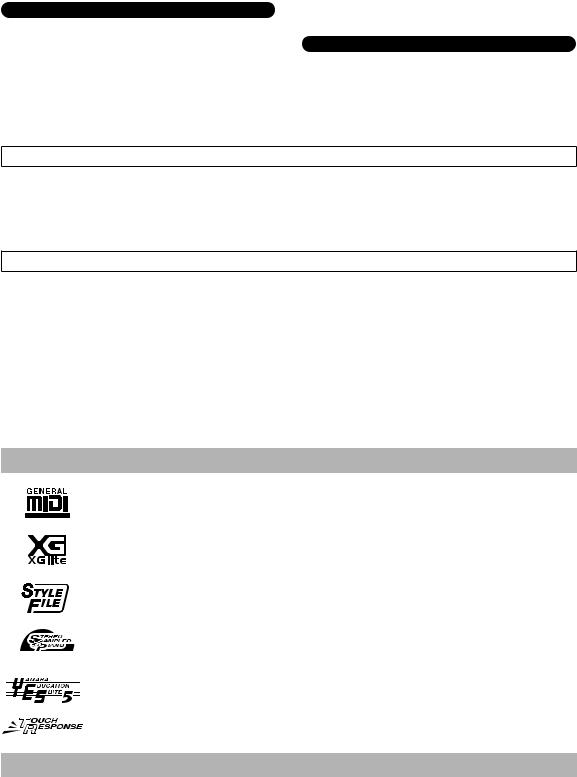
Handling caution
•Do not insert a finger or hand in any gaps on the instrument.
•Never insert or drop paper, metallic, or other objects into the gaps on the panel or keyboard. If this happens, turn off the power immediately and unplug the power cord from the AC outlet. Then have the instrument inspected by qualified Yamaha service personnel.
•Do not place vinyl, plastic or rubber objects on the instrument, since this might discolor the panel or keyboard.
•Do not rest your weight on, or place heavy objects on the instrument, and do not use excessive force on the buttons, switches or connectors.
•Do not use the instrument/device or headphones for a long period of time at a high or uncomfortable volume level, since this can cause permanent hearing loss. If you experience any hearing loss or ringing in the ears, consult a physician.
Saving data
Saving and backing up your data
•Some data items (page 41) are automatically saved as backup data in the internal memory even if you turn the power off.
Saved data may be lost due to malfunction or incorrect operation. Save important data to external device such as a computer.
Yamaha cannot be held responsible for damage caused by improper use or modifications to the instrument, or data that is lost or destroyed.
Always turn the power off when the instrument is not in use.
When using a power adaptor, even when the power switch is in the “STANDBY” position, electricity is still flowing to the instrument at the minimum level. When you are not using the instrument for a long time, make sure you unplug the AC power adaptor from the wall AC outlet.
Make sure to discard used batteries according to local regulations.
The illustrations and LCD screens as shown in this owner’s manual are for instructional purposes only, and may appear somewhat different from those on your instrument.
● COPYRIGHT NOTICE
This product incorporates and bundles computer programs and contents in which Yamaha owns copyrights or with respect to which it has license to use others’ copyrights. Such copyrighted materials include, without limitation, all computer software, style files, MIDI files, WAVE data, musical scores and sound recordings. Any unauthorized use of such programs and
contents outside of personal use is not permitted under relevant laws. Any violation of copyright has legal consequences. DON’T MAKE, DISTRIBUTE OR USE ILLEGAL COPIES.
Copying of the commercially available musical data including but not limited to MIDI data and/or audio data is strictly prohibited except for your personal use.
● Trademarks
•Windows is the registered trademarks of Microsoft® Corporation.
•The company names and product names in this Owner’s Manual are the trademarks or registered trademarks of their respective companies.
Formats and functions
GM System Level 1: “GM System Level 1” is an addition to the MIDI standard which ensures that any GM-compatible music data can be accurately played by any GM-compatible tone generator, regardless of manufacturer. The GM mark is affixed to all software and hardware products that support GM System Level.
XGlite: As its name implies, “XGlite” is a simplified version of Yamaha’s high-quality XG tone generation format. Naturally, you can play back any XG song data using an XGlite tone generator. However, keep in mind that some songs may play back differently compared to the original data, due to the reduced set of control parameters and effects.
Style File: The Style File Format combines all of Yamaha’s auto accompaniment know-how into a single unified format.
Stereo Sampled Piano: The instrument has a special Portable Grand Piano Voice—created by state-of- the-art stereo sampling technology and using Yamaha’s sophisticated AWM (Advanced Wave memory) tone generation system.
Yamaha Education Suite 5: The instrument features the new Yamaha Education Suite—a set of learning tools that utilize the latest technology to make studying and practicing music more fun and fulfilling than ever before!
Touch Response: The exceptionally natural Touch Response feature, with a convenient front panel on/off switch, gives you maximum expressive level control over the voices.
Supplied Accessories
The PSR-E323/YPT-320 package includes the following items. Please check that you have them all.
• Music rest |
• My Yamaha Product User Registration |
• Owner’s manual (this book) |
* The PRODUCT ID on the sheet will be needed when you fill |
|
out the User Registration form. |
(4)-13 |
2/2 |
PSR-E323/YPT-320 Owner’s Manual |
5 |
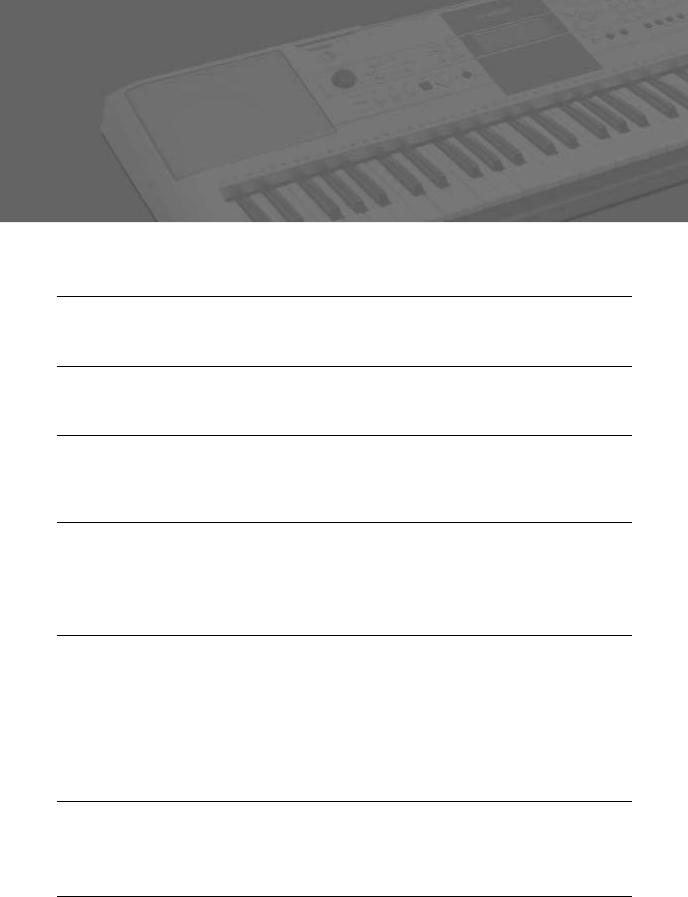
What You Can Do With the
PSR-E323/YPT-320
Playing
Changing Voices
> pages 12, 13
The instrument Voice that sounds when you play the keyboard can be changed to violin, flute, harp, or any of an extensive range of voices. You can also restore the piano settings with a simple press of a button.
Adding Reverb to the sound |
>page 43 |
The reverb effects add a warm ambience to the sound, simulating the complex reflections of actual performance spaces, such as a concert hall or small club.
Play along with the Styles |
>page 18 |
You can select from 100 different styles (auto accompaniment) for playing along on the keyboard— giving you the equivalent of a full backing band, covering a wide variety of styles from waltzes to 8- beat to euro-trance ... and much more.
Play Using the Music Database |
>page 36 |
Simply selecting your favorite style such as rock or jazz from the Music Database calls up the appropriate Voice and Styles that matches the selected style.
Practicing
Practicing and mastering Songs
>pages 28, 31, 35
You can practice the preset Songs using these lesson functions: “Keys to Success” (page 28), “Listening, Timing, Waiting” (page 31) and “Phrase Repeat” (page 35). Keys to Success helps familiarize you with playing a specific Song, while Listening, Timing, Waiting helps you to learn how to play correct notes with the correct timing. Finally, Phrase Repeat lets you repeatedly practice a specified phrase in the Song. Keys to Success is ideal for customers using the keyboard instrument for the first time.
Listening
Listening to the Songs >page 16
The instrument contains a wide variety of 102 preset songs.
Recording
Recording your performance >page 37
You can record up to five of your own performances as User Songs.
6 PSR-E323/YPT-320 Owner’s Manual
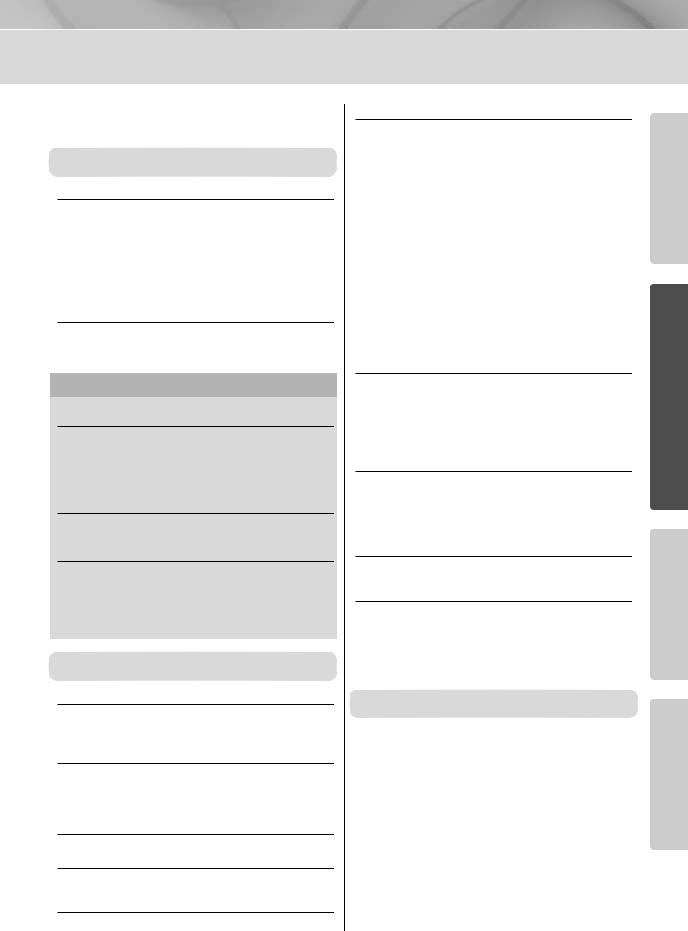
Contents |
|
Formats and functions ............................................... |
5 |
Supplied Accessories................................................. |
5 |
Setting Up |
|
Setting Up |
8 |
Power Requirements ................................................. |
8 |
Audio Connections — |
|
Headphones and External Equipment.................... |
9 |
Connecting a footswitch............................................. |
9 |
Turn on the power...................................................... |
9 |
Using the music rest .................................................. |
9 |
Removing the protective film...................................... |
9 |
Panel Controls and Terminals |
10 |
Front Panel .............................................................. |
10 |
Rear Panel ............................................................... |
10 |
Quick Guide |
|
Changing the Voices |
12 |
Try playing a variety of instrument Voices ............... |
12 |
Playing the Grand Piano Voice ................................ |
13 |
Using the Metronome............................................... |
14 |
Playing the Drum Kit Voice ...................................... |
15 |
Playing Songs |
16 |
Select and Listen to a Specific Song ....................... |
16 |
Play with a Style |
18 |
Play along with the styles......................................... |
19 |
Changing the tempo of the Style.............................. |
22 |
Pattern Variation (Sections) ..................................... |
23 |
Playing chords along with score of the Song ........... |
24 |
Chords ..................................................................... |
25 |
Reference |
|
Basic Operation and Displays |
26 |
Basic Operation ....................................................... |
26 |
Display ..................................................................... |
27 |
Song Lesson |
28 |
Keys to Success ...................................................... |
28 |
Listening Timing Waiting.......................................... |
31 |
Phrase Repeat ......................................................... |
35 |
Play Using the Music Database |
36 |
Record your own performance |
37 |
Recording to a specified track.................................. |
38 |
Initialization |
41 |
Initialization .............................................................. |
41 |
Voice Settings |
42 |
Adding Harmony...................................................... |
42 |
Adding Reverb......................................................... |
43 |
Adding Chorus......................................................... |
43 |
Adding Panel Sustain .............................................. |
44 |
Touch Response Sensitivity .................................... |
44 |
Playing Two Voices Simultaneously—Dual............. |
45 |
Playing Different Voices with the Left and Right |
|
Hands—Split........................................................ |
46 |
Setting the Split Point .............................................. |
47 |
Adjusting the Voice volume ..................................... |
47 |
Setting the Metronome Beats per Measure, |
|
and the Length of Each Beat ............................... |
48 |
Setting the Metronome Volume............................... |
48 |
Octave ..................................................................... |
49 |
Transpose ............................................................... |
49 |
Tuning ..................................................................... |
50 |
One Touch Setting .................................................. |
50 |
Song settings |
51 |
Mute ........................................................................ |
51 |
A-B Repeat.............................................................. |
51 |
Song Volume........................................................... |
52 |
Tap Start.................................................................. |
52 |
Changing the Melody Voice .................................... |
52 |
Style (Auto Accompaniment) Functions |
53 |
Starting Style playback............................................ |
53 |
Adjusting the Style Volume ..................................... |
53 |
Looking up Chords Using the Chord Dictionary ...... |
54 |
Registering Style Files............................................. |
55 |
Function Settings |
56 |
Select the item and change the value ..................... |
56 |
About MIDI |
58 |
What is MIDI?.......................................................... |
58 |
Transferring Performance Data To and |
|
From Another Instrument..................................... |
58 |
Transferring data between the PSR-E323/YPT-320 |
|
and a computer.................................................... |
60 |
Appendix |
|
Troubleshooting ........................................................... |
63 |
Voice List....................................................................... |
64 |
Maximum Polyphony ............................................... |
64 |
Drum Kit List ................................................................. |
68 |
Style List........................................................................ |
70 |
Music Database List ..................................................... |
71 |
Song List ....................................................................... |
72 |
Effect Type List ............................................................. |
73 |
Specifications ............................................................... |
74 |
Index .............................................................................. |
75 |
PSR-E323/YPT-320 Owner’s Manual |
7 |
Setting Up
Quick Guide
Reference
Appendix
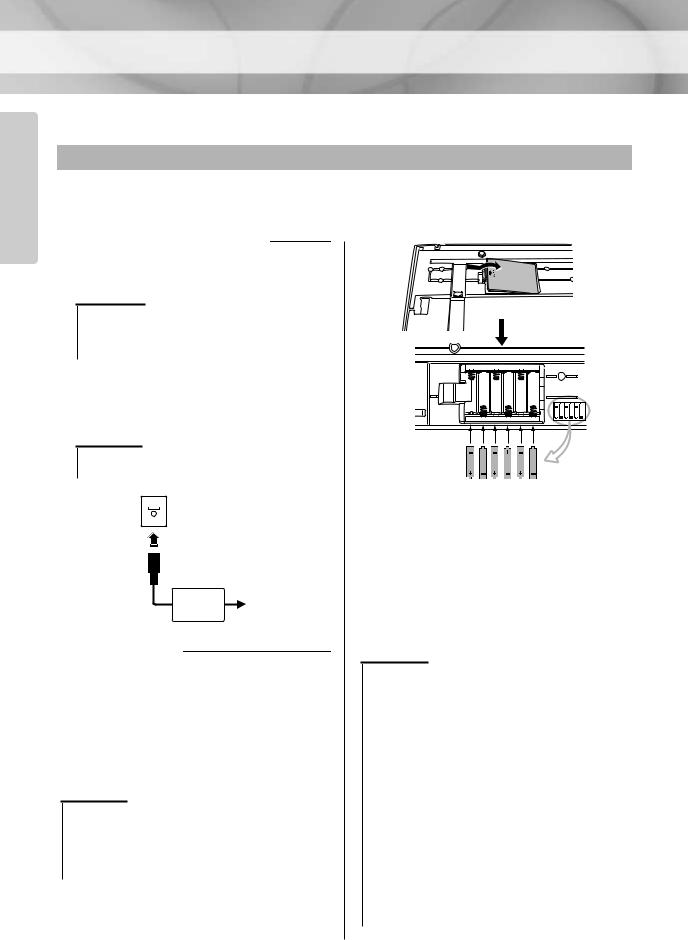
Setting Up
Setting Up
Up Setting
Be sure to do the following operations BEFORE turning on the power.
Power Requirements
Although the instrument will run either from an optional AC adaptor or batteries, Yamaha recommends use of an AC adaptor whenever possible. An AC adaptor is more environmentally friendly than batteries and does not deplete resources.
■ Using an AC Power Adaptor
q Make sure that the power of the instrument is off (the backlit display is off).
 WARNING
WARNING
•Use the specified adaptor (PA-130, or an equivalent recommended by Yamaha) only. The use of other adaptors may result in irreparable damage to both the adaptor and the instrument.
w Connect the AC power adaptor to the power supply jack.
e Plug the AC adaptor into an AC outlet.
 CAUTION
CAUTION
•Unplug the AC Power Adaptor when not using the instrument, or during electrical storms.
w 
e
AC power |
AC outlet |
|
adaptor |
||
|
■ Using Batteries
q Open the battery compartment cover located on the instrument’s bottom panel.
w Insert the six new alkaline batteries, being careful to follow the polarity markings on the side of the compartment.
e Replace the compartment cover, making sure that it locks firmly in place.
 CAUTION
CAUTION
•Never connect or disconnect the AC power adaptor when the batteries are installed in the instrument and the power is on. Doing so will turn the power off, possibly resulting in loss of the data being transferred and the data currently in the transfer destination during transferring or recording a data.
8 PSR-E323/YPT-320 Owner’s Manual
For battery operation the instrument requires six 1.5V “AA” size, LR6 or equivalent batteries. (Alkaline batteries are recommended.) When battery power becomes too low for proper operation, the volume may be reduced, the sound may be distorted, and other problems may occur. When this happens, make sure to replace all batteries, following the precautions listed below.
If necessary, also make sure to save all important User data (see page 62), since custom panel settings are lost when the batteries are removed.
 CAUTION
CAUTION
•Use alkaline batteries for this instrument. Other types of batteries (including rechargeable batteries) may have sudden drops of power when battery power becomes low, possibly resulting in loss of data in the flash memory.
•Make sure to install the batteries with the proper orientation, maintaining the correct polarity (as shown). Incorrect battery installation may result in heat, fire and/or leaking of corrosive chemicals.
•When the batteries run down, replace them with a complete set of six new batteries. NEVER mix old and new batteries. Do not use different kinds of batteries (e.g. alkaline and manganese) at the same time.
•If the instrument is not to be in use for a long time, remove the batteries from it, in order to prevent possible fluid leakage from the battery.
•Please use the power adaptor when transferring data to flash memory. Batteries (including rechargeable types) can be drained rapidly by this type of operation. If the batteries do become drained during a data transfer, both the data being transferred and the data currently in the transfer destination will be lost.
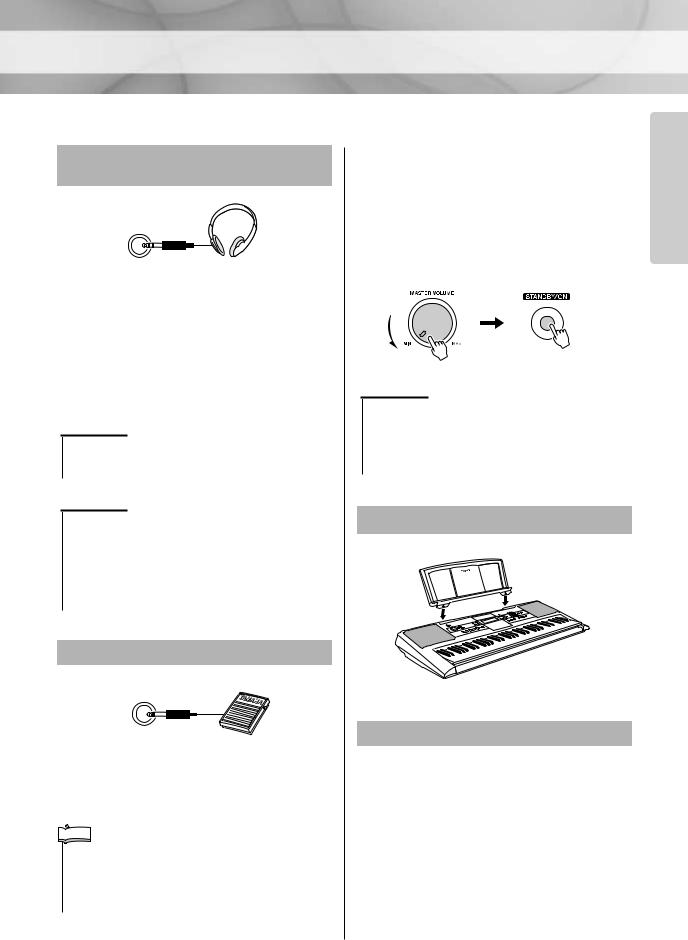
Setting Up
Make all necessary connections BEFORE turning the power on.
Audio Connections —
Headphones and External Equipment
You can connect the PHONES/OUTPUT jack to a set of headphones, keyboard amplifier, stereo system, mixer, tape recorder, or other line-level audio device to send the instrument’s output signal to that device.
The internal speakers are automatically shut off when a plug is inserted into this jack. The PHONES/OUTPUT jack also functions as an external output.
 CAUTION
CAUTION
•Avoid listening with the headphones at high volume for long periods of time; doing so may not only result in ear fatigue, it may be damaging to your hearing.
 CAUTION
CAUTION
•To prevent damage to the speakers, set the volume of the external devices at the minimum setting and turn power off the devices before connecting them. Failure to observe these precautions may result in electric shock or equipment damage. Also, be sure to set the volumes of all devices at their minimum levels and gradually raise the volume controls while playing the instrument to set the desired listening level.
Connecting a footswitch
The sustain function lets you produce a natural sustain as you play by pressing an optional footswitch. Plug the Yamaha FC4 or FC5 footswitch into the SUSTAIN jack and use it to switch sustain on and off.
 NOTE
NOTE
•Make sure that the footswitch plug is properly connected to the SUSTAIN jack before turning on the power.
•Do not press the footswitch while turning the power on. Doing this changes the recognized polarity of the footswitch, resulting in reversed footswitch operation.
Turn on the power |
Up |
|
|
Turn down the volume by turning the [MASTER |
Setting |
|
|
VOLUME] control to the left and press the |
|
[STANDBY/ON] switch to turn on the power. While |
|
playing the keyboard, adjust the volume level by using |
|
the [MASTER VOLUME] control. Pressing the |
|
[STANDBY/ON] switch again turns the power off. |
|
 CAUTION
CAUTION
•When using a power adaptor, even when the power is off, a small amount of electricity is still being consumed by the instrument.When you are not using the instrument for a long time, make sure to unplug the AC power adaptor from the wall AC outlet, and/or remove the batteries from the instrument.
Using the music rest
Insert the music rest into the slots as shown.
Removing the protective film
Remove the transparent protective film that was applied to the display prior to shipment from the factory.
PSR-E323/YPT-320 Owner’s Manual |
9 |
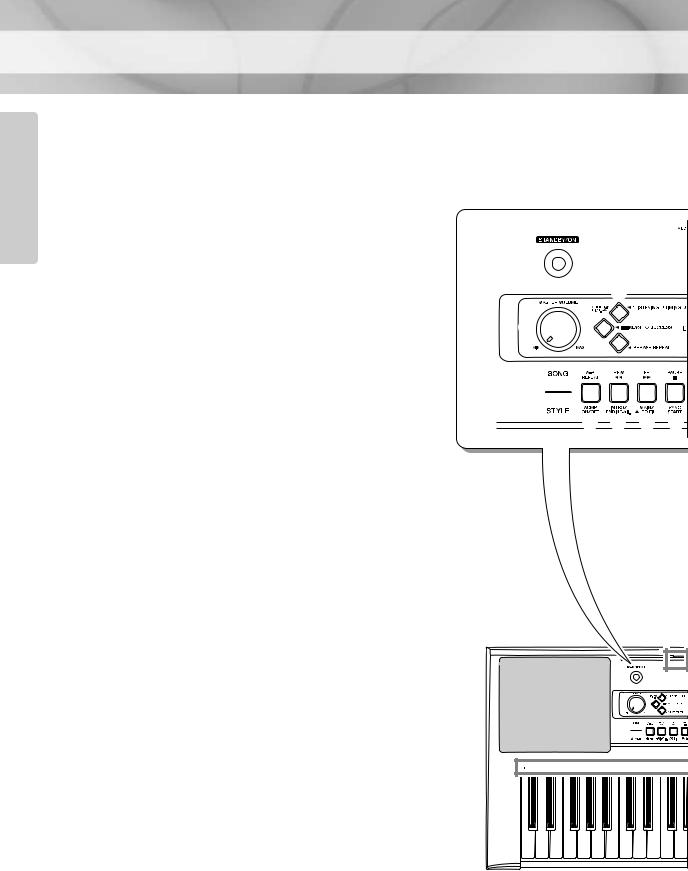
Up Setting
Panel Controls and Terminals
■ Front Panel
q [STANDBY/ON] switch .......................................... |
page 9 |
w [MASTER VOLUME] control ............................... |
pages 9 |
e [1 LISTENING 2 TIMING 3 WAITING] button.... pages 32
r [KEYS TO SUCCESS] button............................ |
pages 28 |
|
t [PHRASE REPEAT] button ............................... |
pages 35 |
|
|
|
|
When the lesson mode |
|
|
|
|
|
y PART |
|
|
[L] button ............................................................. |
page 32 |
|
[R] button............................................................. |
page 32 |
|
|
|
|
When the recording mode |
|
|
|
|
|
y [REC TRACK 2] button........................................ |
page 39 |
|
[REC TRACK 1] button........................................ |
page 39 |
|
|
|
|
u [METRONOME] button.................................. |
page 14, 48 |
|
i [TEMPO/TAP] button............................... |
page 22, 52, 53 |
|
o [SONG] button................................................... |
pages 16 |
|
!0[VOICE] button .................................................. |
pages 12 |
|
!1[STYLE] button.................................................. |
pages 19 |
|
!2Number buttons [0]–[9], [+/YES], [-/NO] ............ |
page 26 |
|
!3[FUNCTION] button........................................... |
pages 56 |
|
!4[DEMO] button..................................................... |
page 17 |
|
|
|
|
When the Song mode |
|
|
|
|
|
!5[A-B REPEAT] button.......................................... |
page 51 |
|
!6[REW] button ....................................................... |
page 17 |
|
!7[FF] button ........................................................... |
page 17 |
|
!8[PAUSE] button.................................................... |
page 17 |
|
|
|
|
When the Style mode |
|
|
|
|
|
!5[ACMP ON/OFF] button ...................................... |
page 20 |
|
!6[INTRO/ENDING/rit.] button................................ |
page 23 |
|
!7[MAIN/AUTO FILL] button................................... |
page 23 |
|
!8[SYNC START] button................................... |
page 19, 53 |
|
|
|
|
!9[START/STOP] button ......................................... |
page 17 |
|
@0[REC] button........................................................ |
page 37 |
|
@1[PORTABLE GRAND] button.............................. |
page 13 |
|
@2[MUSIC DATABASE] button................................ |
page 36 |
|
@3[REVERB] button ................................................ |
page 43 |
|
@4[SPLIT] button ..................................................... |
page 46 |
|
@5[DUAL] button...................................................... |
page 45 |
|
@6[HARMONY] button............................................. |
page 42 |
|
@7[TOUCH] button................................................... |
page 44 |
|
@8Drum Kit............................................................... |
page 15 |
|
■ Rear Panel |
|
|
@9MIDI IN/OUT terminals ........................................ |
page 58 |
|
#0SUSTAIN jack......................................................... |
page 9 |
|
#1PHONES/OUTPUT jack ......................................... |
page 9 |
|
#2DC IN 12V jack....................................................... |
page 8 |
|
■ Front Panel
q |
|
|
e |
w |
r |
|
|
|
t |
! !6 ! !8
@8




















10 PSR-E323/YPT-320 Owner’s Manual
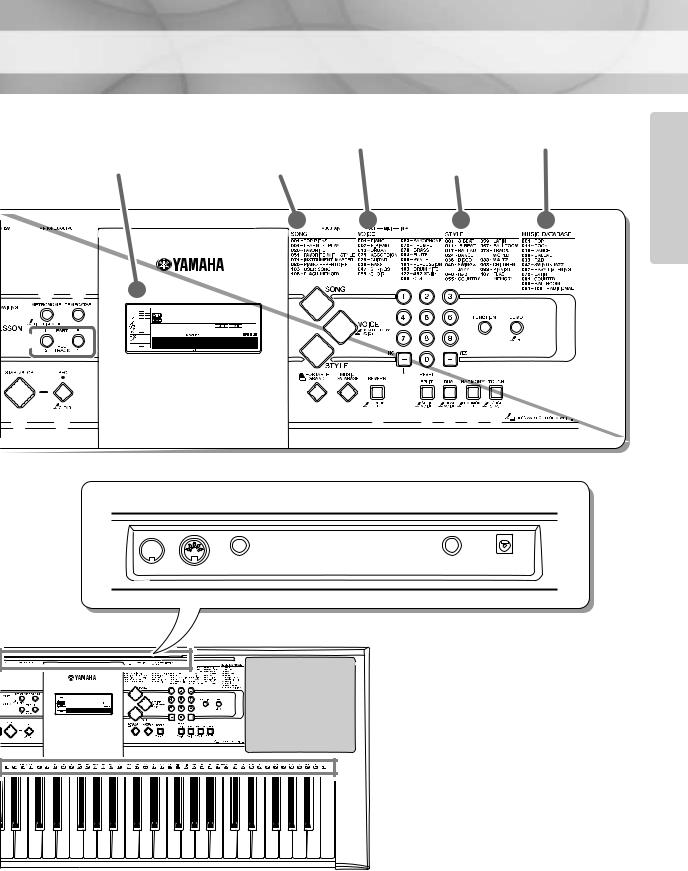
Panel Controls and Terminals
Voice List (page 64) Music Database List (page 71)
Display (page 27) |
Song List (page 72) |
Style List (page 70) |
u |
i |
|
!2 |
|
o |
|
|
||
|
001 GrandPno |
|
!3 !4 |
|
|
!0 |
|
|
|
|
001 |
|
|
|
y |
|
|
|
|
|
!1 |
|
|
|
|
|
|
|
|
!9 |
@0 |
@1 @2 |
@3 |
@4@5@6@7 |
|
|
|
■ Rear Panel
 @9 #0 #1 #2
@9 #0 #1 #2
Setting Up


 001 GrandPno
001 GrandPno


 001
001
PSR-E323/YPT-320 Owner’s Manual 11

Changing the Voices
Quick Guide
This instrument features a variety of realistic, built-in voices. The grand piano Voice is automatically selected whenever the power is turned on, but you can easily change this guitar, drum, or any of an extensive range of voices.
Grand Piano Voice
1 2
Guide Quick
Try playing a variety of instrument Voices
1 Press the [VOICE] button.
The Voice number and name are displayed.
Voice number |
Voice name |


 001 GrandPno
001 GrandPno


 001
001
12 PSR-E323/YPT-320 Owner’s Manual
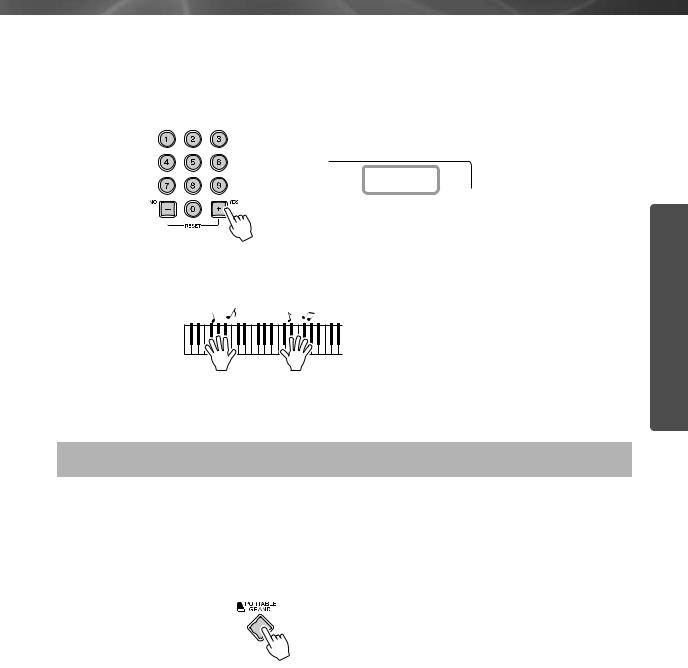
Changing the Voices
2 Select a Voice.
Select the desired Voice by using the number buttons [0]–[9], [+], [-].
Refer to the Voice List on page 64.
084 Flute |
|
The Voice shown here |
|
||
|
becomes the Main Voice |
|
|
|
for the instrument. |
3 Play the keyboard.
Try selecting and playing different Voices.
Playing the Grand Piano Voice
When you simply want to play a piano Voice, all you have to do is press one convenient button.
Press the [PORTABLE GRAND] button.
The Voice “Grand Piano” will automatically be selected as the
Main Voice.
Quick Guide
PSR-E323/YPT-320 Owner’s Manual 13

Changing the Voices
Percussion and
Metronome |
|
drum icons |
|
|
|
|
|
|
|
|
|
Guide Quick
Using the Metronome
The instrument features a built-in metronome (a device that keeps an accurate tempo) that is convenient for practicing.
Press the [METRONOME] button to start the metronome. To stop the metronome, press the [METRONOME] button again.
If you want to adjust the metronome tempo, press the [TEMPO/ TAP] button to call up the Tempo setting in the display, then press the [+] button to raise the tempo, or press the [-] button to lower it. You can also set the tempo using the number buttons on the front panel.
Current Tempo value
070 Tempo
 NOTE
NOTE
•You can set the time signature (page 48).
14 PSR-E323/YPT-320 Owner’s Manual

Changing the Voices
Playing the Drum Kit Voice
When Voice number 109 (Drum Kit) is selected in step 2 on page 13, you can play different percussion sounds directly from the keyboard.
To check which percussion sounds are assigned to each key when you select Voice number 109, look at the icons printed above the keys. You can select and play the desired Drum Kit from 12 preset Drum Kits (Voice number 109–121). Details on the instruments and key assignments of each Drum Kit can be found in the Drum Kit List on page 68.
Quick Guide
PSR-E323/YPT-320 Owner’s Manual 15

Playing Songs
This instrument has 102 built-in Songs. For this instrument, the term “Song” refers to the data that makes up a piece of music.
Listening to a Song.
3 1 2
Guide Quick
Select and Listen to a Specific Song
1 Press the [SONG] button.
The Song number and name are displayed.
Song number “004” is automatically selected whenever the power is turned ON.
Song number |
Song name |
004 Elise 1


 -01
-01
The songs are organized by category. For details, see page 72.
 NOTE
NOTE
•When you want to select the Song number 001–003, use the number buttons [0]–[9], [+], [-].
16 PSR-E323/YPT-320 Owner’s Manual

2
3
Select a Song.
Select the desired song by using the number buttons [0]–[9], [+], [-].
Refer to the Song List on page 72.
Press the [START/STOP] button.
The Song will begin playing.
You can stop playback at any time by pressing the [START/ STOP] button.
Playing Songs
 NOTE
NOTE
•You can play Songs recorded from the instrument or transferred from a computer. The procedure for playing these Songs is the same as that of the built-in Songs.
 NOTE
NOTE
•Songs can be played at any tempo you desire—fast or slow (page 22).
Quick Guide
●Rewind/Fast-forward/Pause
[REW] button ........... Fast-reverses the Song if pressed during playback (no sound is heard
|
during fast reverse). Decreases the measure number if pressed while |
|
playback is stopped. |
[FF] button................ |
Fast-forwards the Song if pressed during playback. Increases the |
|
measure number if pressed while playback is stopped. |
[PAUSE] button ........ |
Temporarily stops playback. Press this button a second time to resume |
|
playback from the point at which it was stopped. |
● Using the [DEMO] button
Press the [DEMO] button to play Songs 001, 002, 003, in sequence, and playback will continue repeatedly starting again from the first Song 001. You can stop playback at any time by pressing the [DEMO] button.
PSR-E323/YPT-320 Owner’s Manual 17
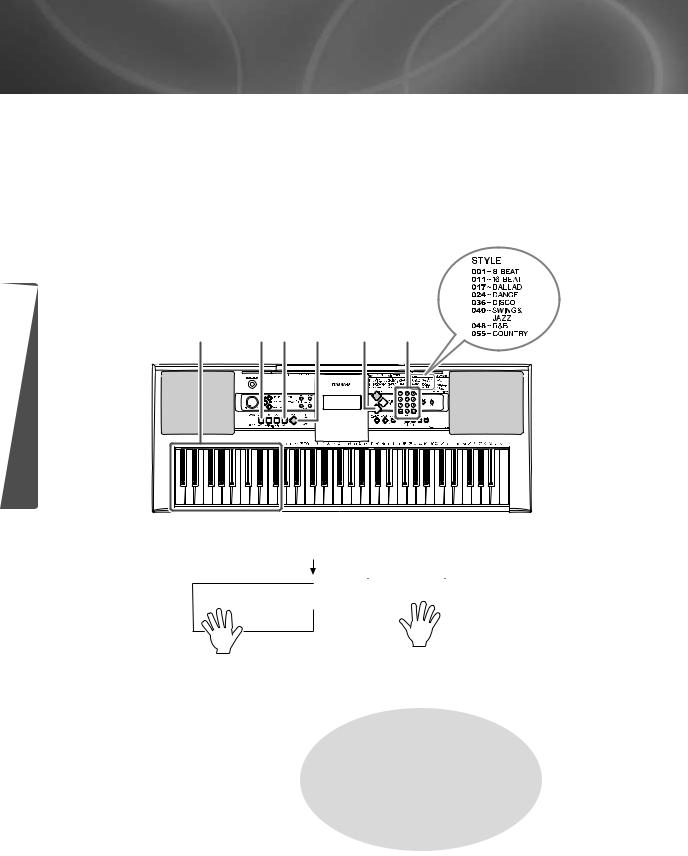
Play with a Style
Styles are rhythm/accompaniment patterns and are played by the auto accompaniment feature.You can select from a wide variety of rhythmic types—rock, blues, Euro trance, and many, many more. Here we’ll learn how to select and play Styles using chords.
While you play, you can automatically add specially created intros and endings, as well as variations in the rhythm/chord patterns, for more dynamic, professional-sounding performances.
5 |
4 3 |
6 |
1 |
2 |
Guide Quick
Split Point
|
|
|
|
|
|
|
|
|
|
|
|
|
|
|
|
|
|
|
|
|
|
|
|
|
|
|
|
|
|
|
|
|
|
|
|
|
|
|
|
|
|
|
|
|
|
|
|
|
|
|
|
|
|
|
|
|
|
|
|
|
|
|
|
|
|
|
|
|
|
|
|
|
|
|
|
|
|
|
|
|
|
|
|
|
|
|
|
|
|
|
|
|
|
|
|
|
|
|
|
|
|
|
|
|
|
|
|
|
|
|
|
|
|
|
|
|
|
|
|
|
|
|
|
|
|
|
|
|
|
|
|
|
|
Play a melody with |
|
|
|
|||||||
|
|
|
|
|
|
|
|
|
|
|
|
|
|
|
|
|
|
|
|
|
||||||||
|
|
|
|
|
|
|
|
|
|
|
|
|
|
|
|
|
|
|
|
|
||||||||
|
|
Auto Accompani- |
|
|
|
|
|
|
|
|
your right hand. |
|
|
|
||||||||||||||
|
|
|
|
|
|
|
|
|
|
|||||||||||||||||||
|
|
|
ment range |
|
|
|
|
|
|
|
|
|
|
|
|
|
|
|
|
|||||||||
|
|
|
|
|
|
|
|
|
|
|
|
|
|
|
|
|
|
|
|
|
|
|
|
|
|
|||
|
Try playing chords |
|
|
|
|
|
|
|
|
|
|
|
|
|
||||||||||||||
|
with your left hand. |
|
|
|
|
|
|
|
|
|
|
|
|
|
||||||||||||||
Before Performance
Select the “String Ensemble” Voice as the melody Voice, referring to step 2 on page 12.
18 PSR-E323/YPT-320 Owner’s Manual
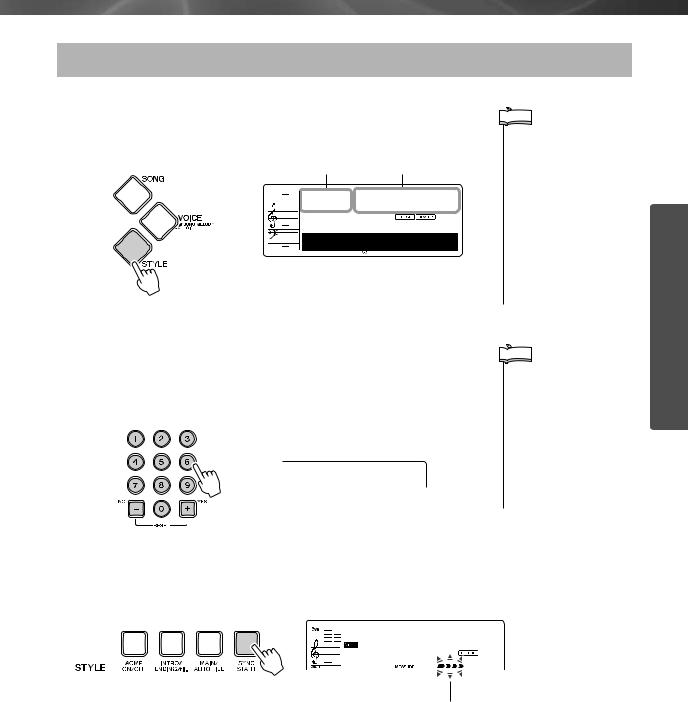
Play with a Style
Play along with the styles
1 Press the [STYLE] button.
The Style number and name are displayed.
Style number |
Style name |


 001 8BtModrn
001 8BtModrn


 001
001
 NOTE
NOTE
•You can also select commercially available Style Files. To do this load the Style Files from the computer to the instrument, and then register the style data starting with to style number 107. (Refer to the information on transferring data on page 61 and registering styles on page 55.) If the Style File has not been registered, “No Data” will be displayed when selecting style number 107.
2 Select a Style.
Select the desired Style by using the number buttons [0]–[9], [+], [-].
Refer to the Style List on page 70.
018 LoveSong
 NOTE
NOTE
•Since the Pianist category Styles (098–106) have no rhythm parts, no sound will be produced if you start rhythm-only playback. To use these Styles, turn on the auto accompaniment and play the keyboard as described on pages 20 (The bass and chord accompaniment parts will sound.)
3 Turn SYNC START on.
Press the [SYNC START] button.
Flashes when Sync
Start is on.
Quick Guide
PSR-E323/YPT-320 Owner’s Manual 19
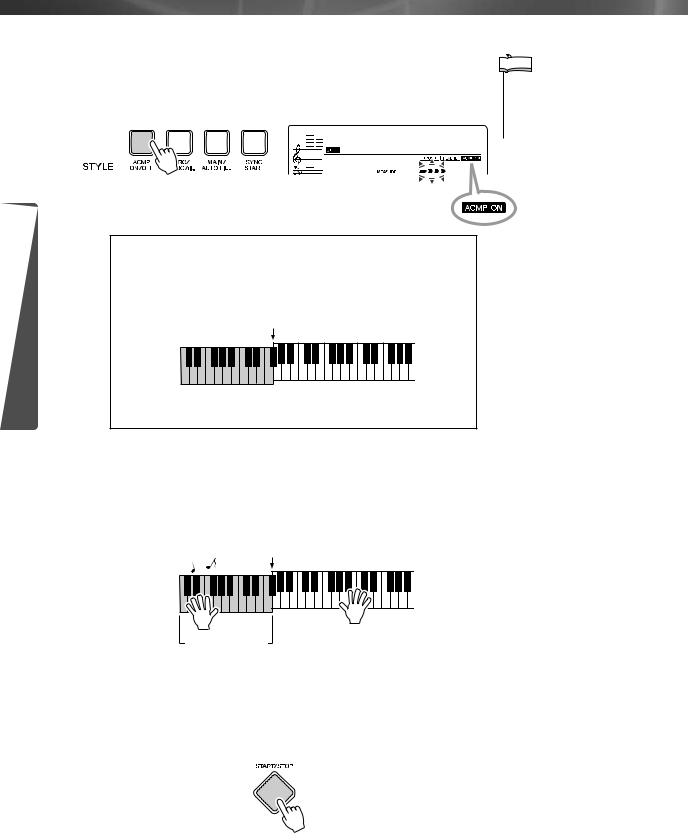
Guide Quick
Play with a Style
4 Turn auto accompaniment on.
Press the [ACMP ON/OFF] button.
Press the [ACMP ON/OFF] button again to turn the auto accompaniment off.
● When auto accompaniment is on ...
The keys to the left of the Split Point (54; F#2) will play only chords.
This is known as the “Auto Accompaniment range.”
Split Point (page 47)
 Auto Accompani-
Auto Accompani- 
ment range
5 Start playing along on the keyboard.
Style playback will begin as soon as you play a chord in the accompaniment range of the keyboard. In this case, try out the Song “Aura Lee” on the next page for practice purpose. For information on how to enter chords, see page 24.
Split Point
Auto Accompani-
ment range
6 Stop playing.
Playback will stop as soon as you press the [START/STOP] button.
 NOTE
NOTE
•If you press the [START/ STOP] button while the auto accompaniment is off, only the rhythm (percussion) parts will start.
Appears when auto accompaniment is on
20 PSR-E323/YPT-320 Owner’s Manual

Play with a Style
Practice
— Aura Lee —
Recommended Style: 018 Love Song |
|
Recommended Voice: 047 String Ensemble |
Composer: G. Poulton |
|
G A D C E D7
Quick Guide
PSR-E323/YPT-320 Owner’s Manual 21
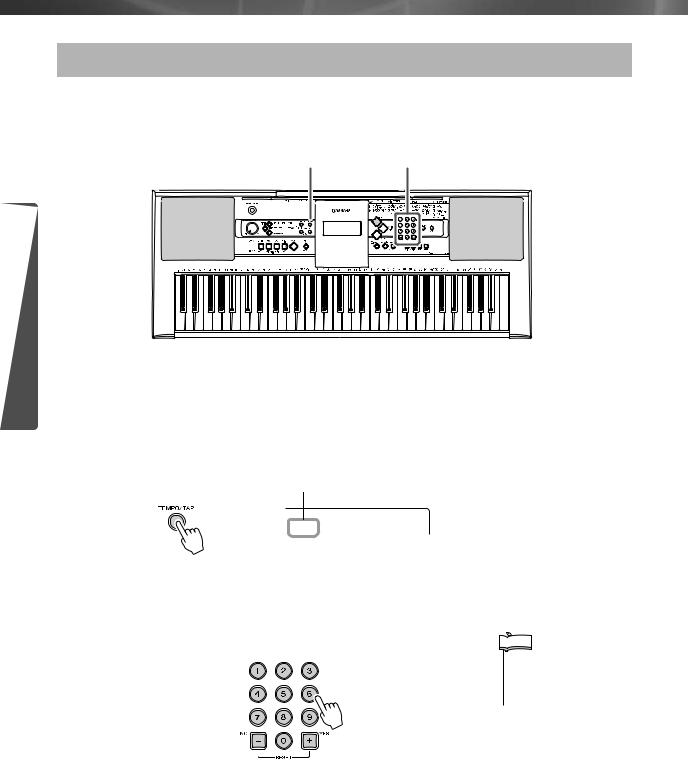
Play with a Style
Changing the tempo of the Style
Styles can be played at any tempo you desire—fast or slow.
1 2
Guide Quick
1 Press the [TEMPO/TAP] button to call up the Tempo setting in the display after selecting a Style.
Current Tempo value
070 Tempo
2 Set the Tempo by using the number buttons [0]–[9], [+], [-].
 NOTE
NOTE
• Press the [+] and [-] buttons simultaneously to instantly reset the value to the default tempo of a Style.
22 PSR-E323/YPT-320 Owner’s Manual
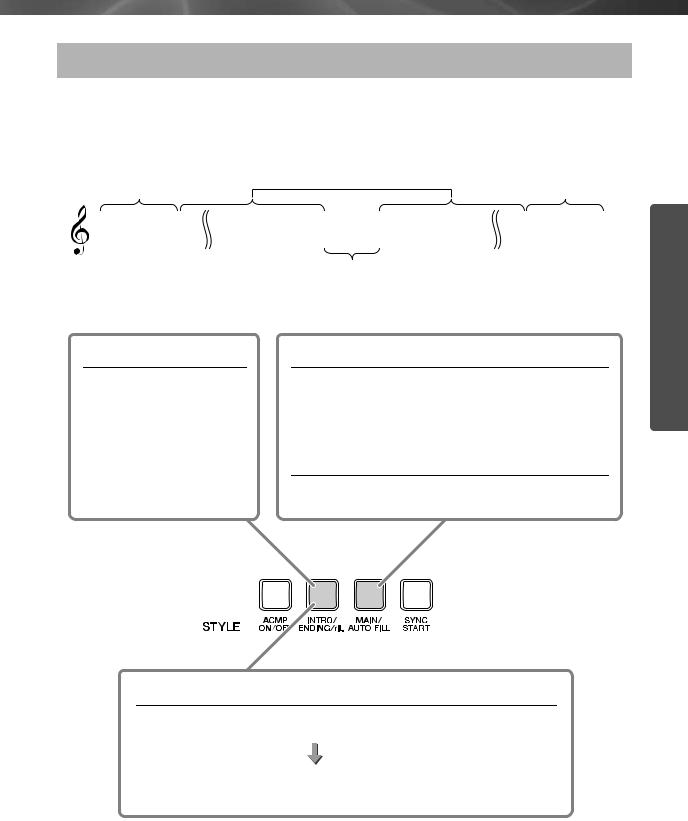
Play with a Style
Pattern Variation (Sections)
The instrument features a wide variety of Style “sections” (patterns) that allow you to vary the arrangement of the accompaniment to match the Song you are playing.
Intro |
Main |
Ending |
|||||||
This is the begin- |
This is the main part of the Song. |
This is the end of |
|||||||
ning of the Song. |
the Song. |
||||||||
|
|
|
|||||||
|
|
|
|
|
|
|
|
|
|
|
|
|
|
|
|
|
|
|
|
|
|
|
|
|
|
|
|
|
|
|
|
|
|
|
|
|
|
|
|
|
|
|
|
|
|
|
|
|
|
Fill in
This is the transition between main patterns.
Adding an Intro
Pressing the [INTRO/ENDING/rit.] button before playing back the Style automatically adds a short introduction before starting the actual (Main) rhythm.
When the intro finishes playing, Style playback shifts to the main section.
Switching Main Patterns
There are two variations on the basic pattern (A and B). These are alternately selected each time the [MAIN/AUTO FILL] button is pressed.
The main accompaniment pattern plays, and repeats indefinitely until another section’s button is pressed.
Adding a Fill-in
A Fill-in pattern is automatically added before changing to section A or B.
Adding an Ending
Press the [INTRO/ENDING/rit.] button to begin playing an ending section. Playback will stop when the ending has played all the way through.
If you press the [INTRO/ENDING/rit.] button a second time (while the ending is playing) the ending will play ritardando (the tempo will gradually get slower).
Quick Guide
PSR-E323/YPT-320 Owner’s Manual 23
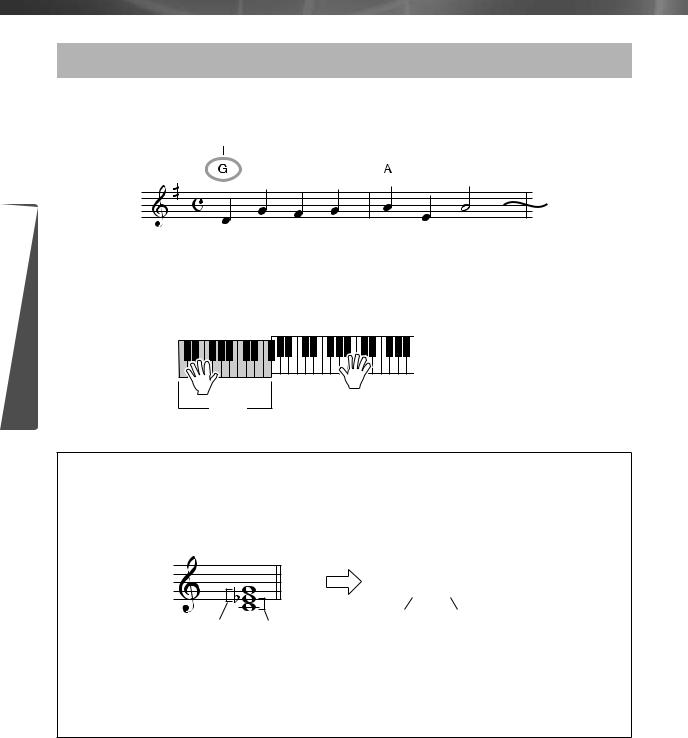
Play with a Style
Guide Quick
Playing chords along with score of the Song
Below is an example of a melody score with chord indications.
Chord
Play the melody on the staff with your right hand, and chords with your left hand. Find the appropriate chords on the next page and play them as illustrated.
Melody
Chords
● Chord names
From the chord name, you can tell at a glance what type of chord it is and which notes make up the chord. Understanding the basic structure of chords is very useful—once you’re familiar with this, you’ll be quickly and easily play chords by looking at the names that appear above the notation.
Cm
Cm
Root note |
Chord type |
Major 3rd |
|
Minor 3rd |
|
|
|
Taking the chord above as an example, the lowest note of this triad is called the “root note.” This is the central note sound, and it supports or anchors the rest of the notes chord. Upper case letters (including sharps or flats) at the left of the chord name shows root note. The chord name is determined by a root note and chord type like as major or minor, and so on.
24 PSR-E323/YPT-320 Owner’s Manual
